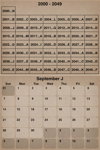 Plenty of cell phones can access the internet, but the iPhone and the iPod Touch have already seemed to capture the attention of the phone and wi-fi public. What are the options for those who want to tease their brain with an iPhone or iPod touch?
Plenty of cell phones can access the internet, but the iPhone and the iPod Touch have already seemed to capture the attention of the phone and wi-fi public. What are the options for those who want to tease their brain with an iPhone or iPod touch?
I've already started work on a new section for the Mental Gym, called the iPhone Mental Gym. At this writing there are only two items in it, Albert Omoss' Sudoku, and my own original Knight's Tour. This version is a special adaption of the Knight's Tour at the Mental Gym, where you can also learn how to do the Knight's Tour.
If you don't have an iPhone, you can try them out online. If you want a fuller iPhone/iPod Touch experience, you can also try out TestiPhone. Just type http://www.testiphone.com/?url= and the web address in your browser's address bar, and try out your own online iPhone! For example, typing http://www.testiphone.com/?url=http://members.cox.net/astonishment/iphone/iknightquiz.html, and you'll get this as the result.
These two aren't the only way to challenge your brain, of course. Want to perform the 40 30s 4 15 feat? First, learn how to do it, and then use stephan.com's iFifteen.
How about a calculator for feats like the root extraction feat? Since numbers for many mathematical feats can become large quickly, I recommend Garth Minette's Belfry SciCalc (TestiPhone version).
I don't want to completely rob you of the joy of discovery, however. Start by checking out AppSafari and iPhone Widget List, and do a little exploring.


 There's only one more day to go until the
There's only one more day to go until the 
 Believe it or not, I haven't covered all the mathematical visualization sites on the web yet.
Believe it or not, I haven't covered all the mathematical visualization sites on the web yet. There are plenty of
There are plenty of 
 Yes, it's time once again for the
Yes, it's time once again for the 


 Did I scare you with the title phrase? It's understandable. It brings up images of math class pressure during tests.
Did I scare you with the title phrase? It's understandable. It brings up images of math class pressure during tests.

